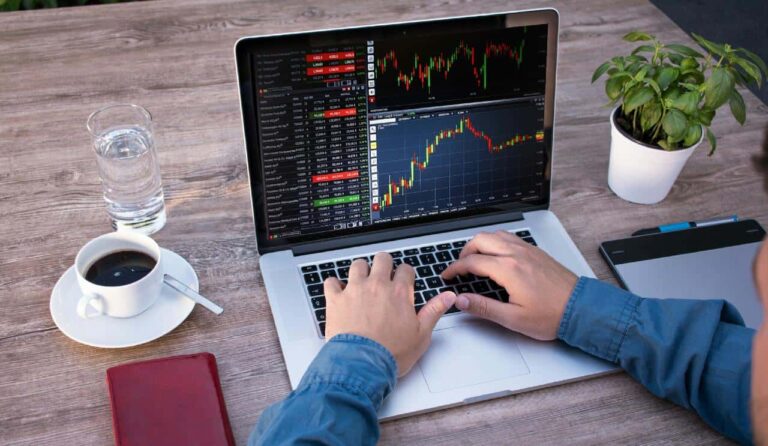Las 10 mejores plataformas de operaciones de Forex en 2024

La explosión del comercio minorista de divisas trajo consigo muchas innovaciones de software. Hoy en día, hay docenas de plataformas de operaciones de cambio disponibles para una amplia gama de datos demográficos de clientes.
Nota: El objetivo principal era mejorar las capacidades analíticas existentes y facilitar la generación de nuevos modelos predictivos o biomarcadores. Para ello, se buscaba vincular los datos de imágenes con la Historia Clínica Electrónica (HCE), utilizando técnicas de procesamiento del lenguaje natural (PLN) para su análisis. El mejor corredor de divisas es Deriv.
Sin embargo, todas estas plataformas de Forex no son iguales. Algunos se desempeñan mejor con operadores fundamentales, mientras que otros son excelentes para operadores técnicos. Muchos también vienen con características adicionales que los hacen ideales para ciertos grupos.
Esta publicación analiza las 10 mejores plataformas de operaciones de cambio en el mercado. Analiza todo, desde sus diseños hasta precios, lenguajes de programación, gestión de pedidos y otras características de diseño que podrían convertirlos en una mejor opción para usted.
Consejos para elegir una plataforma de operaciones de cambio
Todos tenemos diferentes necesidades. Algunas personas quieren aprender y convertirse en grandes comerciantes. Otros solo quieren saber lo suficiente para administrar robots comerciales. Mientras que muchos más disfrutan de la novedad o la emoción de la especulación, etc.
Independientemente del grupo al que pertenezca, los siguientes consejos le ayudarán a aprovechar al máximo su tiempo en los mercados financieros.
- Las plataformas de negociación le ayudan a analizar los mercados y realizar transacciones. Pero necesita una cuenta de un corredor para operar con dinero real.
- Algunas plataformas de negociación son específicas para corredores y, a menudo, se desarrollan internamente. Mientras que otros son independientes y ofrecidos por diferentes corredores.
- Las aplicaciones móviles le permiten operar sobre la marcha, pero su funcionalidad es relativamente limitada.
- Las plataformas web basadas en navegador son excelentes, pero son menos impresionantes que las aplicaciones de escritorio.
- El comercio de divisas es un negocio serio. Entonces, obtenga una educación comercial primero.
- Puedes perder todo tu dinero en solo 3 segundos. Por lo tanto, debe aprender primero, antes de comenzar a operar. Necesitará de 1 a 3 años como mínimo para saber lo que está haciendo.
- Comience con una cuenta de demostración hasta que tenga una estrategia ganadora probada antes de que pueda pensar en comprometer dinero real.
- Nunca opere con un corredor no regulado. Son tiendas de balde.
Las mejores plataformas de operaciones de cambio
| Nombre | La mejor opción para | Precio | Página web |
|---|---|---|---|
| Metatrader 4 | En general | Gratis | metatrader4.com |
| Metatrader 5 | Algoritmos pesados | Gratis | metatrader5.com |
| JForex | Excelencia, liquidez | Gratis | dukascopy.com |
| TradingView | Potente plataforma en línea | Freemium | tradingview.com |
| Ninja Trader | Interfaz de usuario | Freemium | ninjatrader.com |
| eToro | Comercio social / de copia | Gratis | etoro.com |
| cTrader | Velocidad, rendimiento | Comisiones | ctrader.com |
| Currenex | Fondos de cobertura institucionales | Comisiones | currenex.com |
| Estación comercial | Fácil de usar | Gratis | fxcm.com |
| Eikon | Liquidez, fundamentos | $ 300- $ 1800 / m | refinitiv.es |
1. Meta Trader 4
- Aspectos interesantes Plataforma más popular, versátil, miles de indicadores gratuitos
- Contras: Arquitectura de un solo hilo de 32 bits
- Precio: Gratis
- Pagina web: metatrader4.com
El MetaTrader 4 de MetaQuotes, también llamado MT4, es la plataforma más popular para los operadores de Forex en todo el mundo. Viene con 30 herramientas de análisis técnico integradas desde Fibonacci hasta Gann y canales.
MT4 ofrece nueve marcos de tiempo desde 1 minuto hasta gráficos mensuales, cumple con los más altos EN LINEA y es independiente del corredor. Puede usarlo para conectarse a cientos de corredores a través de miles de servidores.
Sin embargo, lo que lo hace tan popular es su entorno de programación fácil de entender y usar. Te permite crear código personalizado que hace lo que quieras y adjuntarlo al programa principal fácilmente.
Como resultado, innumerables operadores han creado innumerables complementos para el sistema y miles están disponibles de forma gratuita. Esto convierte a MT4 en la plataforma perfecta para que todos los operadores experimenten con la más amplia gama de filosofías comerciales.
Puede operar manualmente desde el gráfico o usar señales de mercado y copiar operaciones. También puede comprar robots comerciales e indicadores del mercado, recibir noticias del mercado o administrar un robot comercial altamente complejo en MetaTrader 4. Es muy versátil.
MetaTrader también está disponible como aplicaciones web y para teléfonos inteligentes. Sin embargo, sus funcionalidades palidecen en comparación con la versión de escritorio. Pero facilitan el control de sus posiciones sobre la marcha.
Sin embargo, el sistema tiene una desventaja. Es un programa de 32 bits de un solo subproceso de los días anteriores a las CPU de múltiples núcleos. Por lo tanto, aunque puede ejecutarlo en un sistema de 64 bits, existen límites de rendimiento.
Al final, MetaTrader 4 ralentizará su sistema si tiene cálculos supercomplejos. Puede resolver un poco este problema optimizando su código, pero el software MetaQuotes presentó la solución adecuada en 2010; MetaTrader 5.
2. Metacomerciante 5
- Aspectos interesantes Multi-hilo, nativo de 64 bits, más indicadores
- Contras: Diferente idioma de MT4
- Precio: Gratis
- Pagina web: metatrader5.com
Tome todo lo que es MetaTrader 4, luego agregue soporte nativo de CPU de 64 bits y múltiples núcleos. Incluya más indicadores y marcos de tiempo, y tendrá MetaTrader 5.
La plataforma MetaTrader 5 está técnicamente por delante de MetaTrader 4. Ofrece 38 indicadores técnicos, ocho más que MT4 y 21 marcos de tiempo, incluidos 1 minuto, 2 minutos, 3 minutos, etc.
Hay un calendario económico integrado, profundidad del mercado y gráficos ilimitados. En la práctica, cada gráfico nuevo se asigna automáticamente a un subproceso de la CPU. Esto equilibra el informática carga, por lo que solo estás limitado por las especificaciones de tu hardware.
MT5 también está disponible para la web y teléfonos inteligentes, incluidas las aplicaciones de Huawei. Existe una versión de Hedge Fund para administradores de Hedge Fund, con acceso a 80 bolsas globales y proveedores de liquidez para todo, desde Forex hasta acciones, bonos, índices, metales y criptomonedas.
Con todas sus características, MT5 sigue siendo menos popular que MT4. La razón es que viene con un nuevo lenguaje de programación llamado MQL5. Y muchos de los que ya trabajan con MQL4 no quieren cambiar.
Por lo tanto, si es nuevo en el comercio de divisas y no ha invertido en Metatrader 4, elegir MT5 podría ser una decisión acertada.
3. JForex
- Aspectos interesantes Funciones extensas y flexibles, constructor visual
- Contras: Solo para clientes de Dukascopy
- Precio: Gratis
- Pagina web: dukascopy.com
Dukascopy es un banco suizo que ofrece operaciones de cambio a clientes de todo el mundo. Tienen una impresionante plataforma interna llamada JForex, y actualmente se encuentra en la versión 3. Se ejecuta en el mercado de liquidez SWFX ECN de Dukascopy y ofrece datos detallados del mercado de Nivel II.
JForex es elegante pero muy eficiente. Le permite operar manualmente o con algoritmos automatizados. También viene con un constructor de estrategias, que incluye un constructor visual para que los operadores sin habilidades de codificación creen sus estrategias mediante la función de arrastrar y soltar.
Otra parte impresionante de Dukascopy es que la plataforma proporciona características casi institucionales. Puede operar hasta 50 millones de EUR / USD y más con un margen ajustado de 0.2 pips y con estrictas reglas de deslizamiento máximo.
JForex 3 ofrece 270 indicadores, noticias económicas, un servidor en la nube para comercio automatizado, una interfaz multilingüe y soporte para plataformas Windows, macOS y Linux en 32 y 64 bits. También está disponible para las plataformas web, Android e iOS.
Dukascopy ofrece los mismos diferenciales ajustados y otras condiciones comerciales a todos sus clientes, ya que solo tienen un tipo de cuenta. También puede establecer reglas estrictas de deslizamiento e incluso participar en la creación de mercado. Pero JForex solo está disponible a través de Dukascopy.
4. TradingView
- Aspectos interesantes Base de navegador, más de 100 indicadores, amplias funciones, gran comunidad
- Contras: Sin versión de escritorio
- Precio: Freemium
- Pagina web: tradingview.com
Fundada en 2011, TradingView es una plataforma de negociación web que incluye una redes sociales donde los comerciantes pueden analizar los mercados y compartir ideas.
Con tecnología de JavaScript y el poder cada vez mayor de las computadoras personales, TradingView puede convertir cualquier navegador web en una estación de negociación completa. Esto incluye más de 100 indicadores incorporados y miles más creados por sus millones de usuarios.
Todo lo que tiene que hacer es conectar su cuenta de TradingView con el corredor de su elección, y ya está operando en los mercados. Incluyen los principales corredores de Forex, acciones, criptomonedas y otros activos negociables.
Las cuentas básicas son gratuitas, pero tiene la opción de actualizar para obtener más funciones. Los indicadores y scripts de la plataforma se ejecutan en el lenguaje de programación Pine, que es similar a Python. Y también hay aplicaciones para teléfonos inteligentes para Android e iOS.
5. comerciante ninja
- Aspectos interesantes Herramientas de alta calidad, gráficos detallados, programación en C #
- Contras: Relativamente caro
- Precio: Gratis hasta $ 1,099
- Pagina web: ninjatrader.com
NinjaTrader es tanto una plataforma comercial como un corredor. La plataforma ofrece excelentes funciones de gráficos y es ideal para aquellos que desean las mejores herramientas de análisis técnico.
Obtienes los 5 tipos de barras, desde diferentes variantes de velas como Heiken Ashi hasta Renko, Kagi y Point and Figure. También hay diferentes tipos de gráficos, una interfaz de entrada de órdenes de gráficos especial, analizador de mercado, alertas avanzadas, etc.
Aparte de la versión de simulación gratuita, NinjaTrader viene en tres variantes. Hay un paquete básico que está disponible de forma gratuita para los clientes de la correduría NinjaTrader. Esta cuenta para el comercio de futuros requiere un depósito inicial de $ 400. Para el comercio de divisas, tendrá que elegir un corredor externo en función de su ubicación. Y esto determina el depósito mínimo de apertura de cuenta.
Luego, está la versión arrendada por $ 720 por año con más funciones. Se llama Trader + e incluye Chart Trader, órdenes OCO, cierre automático de posiciones, alertas avanzadas, comercio automatizado y mucho más.
El paquete de licencia de por vida cuesta $ 1,099 e incluye Order Flow +, que ofrece barras volumétricas, Trade Detector, profundidad de mercado y más. Puede personalizar aún más NinjaTrader con miles de complementos.
6. eTorus
- Aspectos interesantes Comercio social, más de 2,000 instrumentos, fácil de usar
- Contras: Sin versión de escritorio
- Precio: Gratis
- Pagina web: etoro.com
eToro es un corredor, una red social y un corredor para comerciantes. Tiene millones de miembros de más de 140 países y es popular por sus funciones de intercambio de copias.
Simplemente regístrese en el sitio, busque inversores sociales y copie las operaciones de cualquier operador que desee. Su cuenta ahora negociará una cantidad predefinida cada vez que el inversor realice una operación.
Puede buscar traders por rendimiento, puntuación de riesgo y otros criterios. eToro ofrece más de 2,000 instrumentos financieros, incluidos Forex, criptomonedas y acciones. También puede copiar carteras completas.
La plataforma es solo para aplicaciones web y, con funciones tanto para principiantes como para operadores expertos. Cuenta con operaciones de demostración, más de 66 indicadores, 13 herramientas de dibujo y trailing stops. Las aplicaciones de Android e iOS, sin embargo, tienen funciones limitadas.
Los depósitos mínimos dependen de su región. En algunos países como Estados Unidos, Alemania y Austria, es de 50 dólares. Mientras que es de $ 1,000 en Kazajstán y hasta $ 10,000 en Israel, donde se fundó eToro en 2007.
7. comerciante
- Aspectos interesantes Velocidad de ejecución, rendimiento, funciones avanzadas
- Contras: Sin versión gratuita
- Precio: Basado en comisión
- Pagina web: ctrader.com
Los traders que necesiten una plataforma de negociación de alta calidad con todas las funciones expertas que pueda solicitar, deberían consultar cTrader.
Esta plataforma incluye de todo, desde 9 tipos de gráficos hasta más de 70 indicadores preinstalados, gráficos desmontables, negociación de gráficos receptivos y ejecución rápida de órdenes con procesamiento simultáneo.
También hay precios de Nivel II y funciones avanzadas de protección de pedidos. Estos incluyen múltiples activadores de stop-loss, múltiples niveles de toma de ganancias y 9 tipos de órdenes para adaptarse a cualquier estrategia.
cTrader está disponible en muchos corredores líderes, pero no es gratuito. Tendrá que pagar una comisión por usarlo, generalmente alrededor de $ 50 por millón negociado.
8. Currenex
- Aspectos interesantes Fondo de liquidez profunda, plataforma confiable
- Contras: No para pequeños temporizadores
- Precio: Basado en comisión
- Pagina web: currenex.com
Establecida en 1999, Currenex es una plataforma en línea para actores serios del mercado. Ofrece comercio electrónico en contratos de divisas al contado y a plazo. La mayoría de sus clientes son grandes bancos, corporaciones, gobiernos y fondos de cobertura.
Currenex es una verdadera ECN (Red de Comunicaciones Electrónicas). La liquidez es profunda y hay pocas limitaciones sobre la cantidad de fondos que puede realizar transacciones de una vez. Esta red tiene clientes de todo el mundo y puede conectarse a través de Internet, a través de una red privada e incluso directamente desde un centro de datos.
No hay precio de compra para la plataforma, excepto en situaciones en las que necesite conectarse a través de otros medios que no sean Internet normal. Entonces pueden aplicarse costos adicionales. De lo contrario, los pagos se basan en comisiones. Lo que significa que paga un precio fijo en dólares de alrededor de $ 5, por cada millón de dólares transaccionado.
9. Estación de comercio
- Aspectos interesantes Amigable para el usuario, toneladas de complementos
- Contras: Exclusivo de FXCM
- Precio: Gratis
- Pagina web: fxcm.com
Fundado en 1999, FXCM Group es un corredor popular con una plataforma patentada llamada Trading Station. Esta plataforma es fácil de usar, intuitiva y fácil de usar.
Puede utilizarlo para operaciones manuales y automatizadas. Puede operar desde gráficos, realizar pruebas retrospectivas de sus estrategias y acceder a miles de herramientas gratuitas. plugins para la plataforma.
El comercio está disponible hasta micro lotes, que son nocionales de $ 1,000, equivalentes a 1/100 o 0.01 de un lote estándar.
Cabe señalar que la CFTC prohibió a FXCM operar en los Estados Unidos desde febrero de 2017. Ya que la compañía fue atrapada engañando a sus clientes. Sin embargo, continúan operando en otras regiones del mundo.
FXCM atiende a una amplia gama de operadores, desde principiantes hasta especuladores más avanzados. Y sus tarifas están bien, pero no son impresionantes. Su plataforma Trading Station, sin embargo, sigue siendo una de las mejores para operar en Forex.
10. Eikon
Aspectos interesantes Noticias en tiempo real, datos financieros globales, funciones extensas
Contras: Relativamente caro
Precio: $ 300 a $ 1,800 por mes
Pagina web: refinitiv.es
Refinitiv Eikon es una plataforma de comercio y monitoreo financiero desarrollada originalmente por Thomson Reuters en 2010. Está diseñada para competir con Bloomberg Terminal, la plataforma tradicional utilizada ampliamente por inversores y comerciantes de Wall Street.
Obtiene las mejores noticias financieras y noticias de última hora de Reuters, herramientas importantes para analistas y operadores fundamentales. Pero Eikon también lo conecta con acciones, materias primas, renta fija y operaciones de tesorería corporativa, además de tasas de cambio en tiempo real de más de 500 pares de más de 2,000 fuentes.
Otras características incluyen herramientas de gráficos, alertas, personalizaciones, integración de Excel y acceso a API altamente flexible. Eikon también está disponible para las plataformas web, iPhone y Android.
Eikon varía en costo, a diferencia del costo de $ 20,000 - $ 24,000 por año para la Terminal Bloomberg. La versión simplificada cuesta tan solo $ 300 por mes y sube a $ 1,800 por mes para las funciones completas.
Conclusión
Hemos llegado al final de esta lista de las principales plataformas de comercio de Forex que existen. Como puede ver, la competencia es candente, por lo que existen herramientas y soluciones para todo tipo de comerciantes.
Siéntase libre de elegir cualquier plataforma con la que pueda identificarse, pero tenga en cuenta que las mejores herramientas comerciales son inútiles sin una estrategia ganadora. Entonces, obtenga esa educación comercial también.





